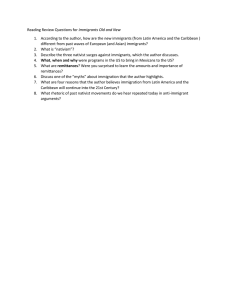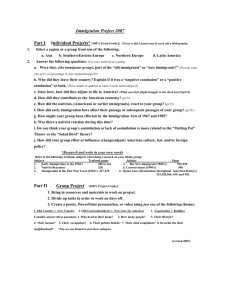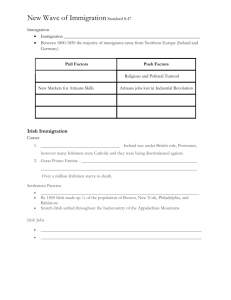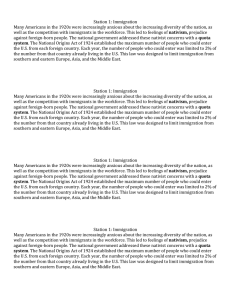Chapter 12 America: A Narrative History 7 th edition
advertisement
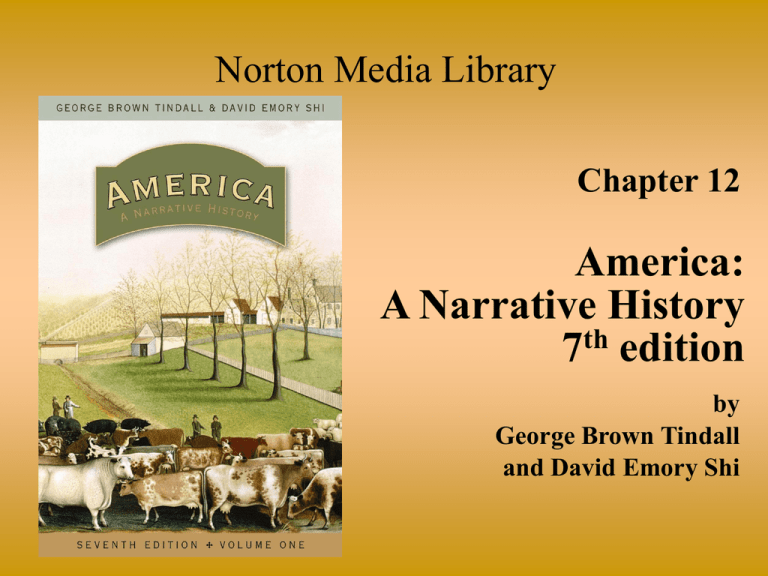
Norton Media Library Chapter 12 America: A Narrative History 7th edition by George Brown Tindall and David Emory Shi I. Agriculture A. Importance of cotton to the economy 1. Invention of the cotton gin 2. Revolutionary impact of the gin a. Impact on slavery b. Encouragement of westward migration c. Cotton became an important export B. Westward movement 1. Statistical evidence 2. Changes in land laws 3. Development of improved iron plows 4. Introduction of the grain reaper II. Improvements in transportation and communication A. Opening new roads B. River transportation 1. Flatboats 2. Steamboats 3. Canal barges 4. Erie Canal 5. Linkages with railroads C. Development of railroads 1. Rails 2. Fuel 3. Advantages of railroad travel D. Early railroad successes II. Improvements in transportation and communication (cont’d) E. Ocean transport 1. Regularly scheduled packet lines 2. Clipper ships F. Financing internal improvements 1. Turnpikes financed by private investment 2. States sponsor canals 3. Railroads soon financed by private investment 4. Federal support for canals and railroads G. Communications revolution 1. Telegraph 2. Mail “express” H. Other technological advances and inventions III. The growth of industry A. Early manufacturing 1. Persistence of the handicraft system 2. Britain’s lead in industrial production 3. Early industrial mills in the United States 4. Impact of the War of 1812 on early textile manufacturing B. Technology 1. Steam engines 2. Practical orientation of American ingenuity 3. The impact of inventions on living conditions a. Rubber b. Sewing machine c. Telegraph III. The growth of industry (cont’d) C. Emergence of the factory system 1. Persistence of the putting-out system 2. The Lowell system a. Features of plan b. Republican values c. Young women workers d. Advantages and problems 3. Competing Fall River system D. Ecological impact 1. Textile mills on rivers 2. Water rights 3. Nature reshaped a. Habitats altered b. Pollution E. Industry and growth of cities 1. Commerce and industry 2. Geographical distribution IV. Popular culture A. Urban recreation 1. Drinking 2. Blood sports B. The theater C. Minstrel shows 1. Folk origins 2. Touring groups 3. Stephen Foster V. Immigration A. To the United States 1. Attraction and need for immigrants 2. Ebb and flow of immigration B. Major ethnic groups 1. The Irish a. Circumstances of immigration b. Demographic details c. Characteristics of Irish life here d. Anti-Irish attitudes e. Linkage to Andrew Jackson f. Ties to the Roman Catholic Church 2. The Germans a. Circumstances of immigration b. Notable immigrants 3. Others a. The British b. The Scandinavians c. The Chinese V. Immigration (cont’d) C. Nativist reaction to immigrants 1. Reasons for antagonism toward immigrants 2. Examples of nativist activity 3. Nativist organizations VI. Labor organizations A. Skilled work in Revolutionary era 1. Hierarchy of guild system 2. Daily routine 3. Trade associations 4. Use of slaves B. Early organizations among craft workers 1. Importance of Commonwealth v. Hunt decision in Massachusetts in 1842 2. Efforts to create national trade unions C. Labor and politics 1. Rise and decline of labor parties 2. Locofocos 3. Reforms D. Revival of unions VII. Rise of the professions A. Specialized knowledge B. Causes 1. Technology 2. Education 3. Literacy revolution C. Examples 1. Writer and publisher 2. Teacher 3. Attorney 4. Physician 5. Engineer D. Role of Women 1. Teaching and nursing 2. Volunteers VIII. Jacksonian inequality A. Examples of self-made men B. Greater likelihood of social stratification C. Increasing social rigidity and inequality in the “Age of the Common Man”
